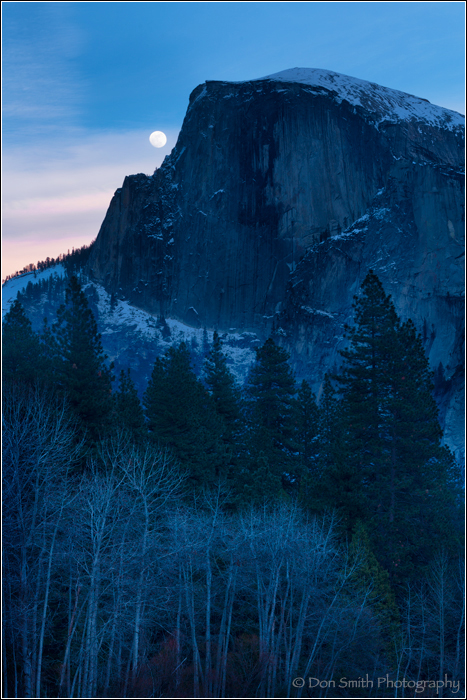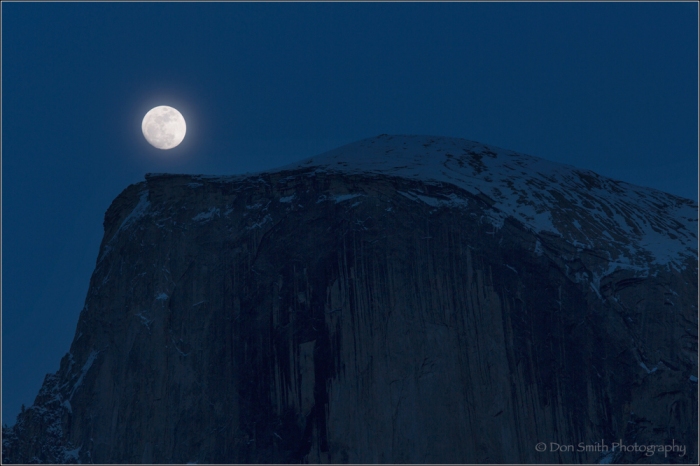Nature's Best :: Don Smith Photography
Exploring our incredible world one image at a time!
Do You Look Or Do You See? Developing Your Creative Vision :: Part 2 of 3
Posted on June 2, 2014
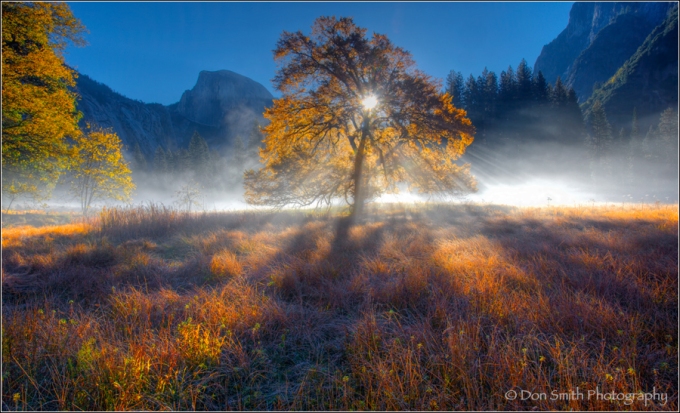
Back-lit Elm, Cooks Meadow, Yosemite National Park
Canon 1DsMKIII, Canon EF 24-70mm f/2.8L II USM Lens, f/22, 1/10th, ISO 100, Lexar Digital Media
This is Part 2 of a 3-part series on developing your creative vision. You can find Part 1 of this series by clicking here.
My path to becoming a full-time landscape photographer has been long a varied. If you read PART 1 of this series, then you know I started photographing landscapes back in my teenage years. You’ll also come away with an understanding that to become a really good photographer, you have to learn your craft and constantly work to improve your creative vision.
Once I turned professional, my landscape work took a backseat to my full-time pursuit of professional sports photography. I never stopped mind you, it was just not the way I made my living. I did that by photographing America’s pro sports: MLB, NBA, NFL, and NHL. Of the four, I still shoot the NHL as co-team photographer for the San Jose Sharks.
This meant lots of travel. My way of relaxing while on the road back then was to actually go out in my off-time and photograph landscapes all over the United States. By my count, I’ve photographed in 48 of our 50 states. Pretty cool!
What it also allowed me to do, was to develop my creative eye for fine art landscape photography without the pressure of having to succeed at it financially to feed my family. Not that sports photography wasn’t creative, but it just involved a completely different mindset.
Passion is what drives me. I was just born to do what I am doing, and believe me, I fought the idea for years! When I finally gave into the fact that this is who I am and this is what I do, then my life really changed (perhaps the old “sink-or-swim” theory kicked in)! One truism: when you dedicate your life to being an artist (in any genre), you will live with a certain amount of financial uncertainty.
Passion is what drives me. I was just born to do what I am doing, and believe me, I fought the idea for years! When I finally gave into the fact that this is who I am and this is what I do, then my life really changed (perhaps the old “sink-or-swim” theory kicked in)!
I never bought in to that old “starving artist” theory, so I made money with my camera shooting commercial work along with sports. Granted there were some jobs I really didn’t want to do, but they helped pay the bills. My dad was self-employed and I learned a lot by watching how he and my mom navigated his business. Hard work and treating people right being at the top of the list.
Looking back, there could have been some really lean years early on. But I was so blessed to have my wife Beri’s love and support – she is still there for me every day – she accepted me and what I do for a living and didn’t try to change me. She also told me that she would work full-time, which in-turn allowed me to grow my business at a steady pace without having to be the main bread-winner.
That freed my mind up to really concentrate on becoming the best photographer that I could be, and I still do it every day of my life. I made a commitment to work at both my craft and creative vision as hard as I could.
Take Time To Develop Your Vision :: It Does Not Happen Overnight
Ten years ago, Beri and I decided to make a go of my landscape photography. That’s another story for another day, but suffice it to say we are still working at it – step-by-step, day-by-day. It’s not an easy path to follow.
In my previous blog, I broke my photography into two parts: Craft (camera / processing) and Vision. I said that if you worked hard at your craft, you could learn it in a year. But that is working every day – most of you don’t have that luxury, so give yourself a bit more time.
Learning the camera is pretty straightforward. Post-processing gets a bit trickier and is really personal. We all read images differently and our processing is a personal statement about the scene that we are presenting. Post-processing in and of itself is a very creative activity.
I can help shortcut you through the process with my new video series: A Simplified Method to Workflow. I show you step-by-step how I process and work you through setting up your computer, processing RAW files and finishing off in Photoshop. I even show luminosity masking, using Tony Kuyper’s luminosity mask action palette. Learn this last step and you can re-create any scene you photographed as you intend (you’ll throw away your HDR programs – guaranteed)! Tony has great tutoriols on his site and I go over the basics in my video series.
So, that brings us to what I consider the most critical part of photography – developing your creative vision. If the craft part can be accomplished in a year or two, then you may be dismayed to hear that vision takes years and years. Really mature vision does not happen quickly – it really is a culmination of all of your life-experiences. You’ll never stop learning how to see, but through the transformation, you’ll stop merely looking. The scene in front of you will become a starting point only for your creativity.
The really cool part is that you’ll start seeing the potential for images everywhere you go! Exotic locations are awesome, but when you make the leap to really seeing, your everyday surroundings can be mined for nuggets!
For me, it started with a serious study of composition, light, art (color and depth), and design. Let’s take a closer look at all four and see how we can tie them together to help your creative vision. For this article, I will discuss my thoughts on composition and light. In Part 3, I’ll discuss the importance of art and design.
The Study Of Composition
The foundation of any good image is a strong composition. If you have a scatter-shot approach to your photography, perhaps you should re-think how you work. Fine Art landscape photography for me was just the opposite of my sports photography work.
I made my living with sports primarily because I loved the sports I was photographing, understood them almost as well as the coaches and players, and I was blessed with really good hand/eye coordination. I worked part-time for Sports Illustrated and started before autofocus lenses were a reality. That meant manual focus on fast-moving subjects with 400mm and 600mm glass. One could either do it or not. Somehow I was born with this talent. I went on to become team co-team photographer for the NHL’s San Jose Sharks (still am today).
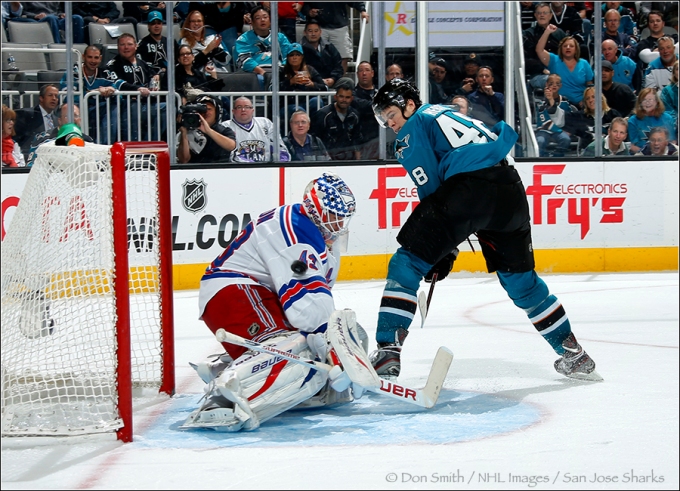
San Jose Sharks Tomas Hertl scores a goal on a shot fired between his legs and over the shoulder of New York Ranger goalie Martin Biron
October 8, 2013, SAP Center, San Jose, California
Canon 1DX, Canon EF 28-300mm f/3.5-5.6L IS USM Lens, f/7.1/ 1/250th sync, ISO 200, PocketWizard MultiMax 32 Channel Transceiver Radio Slave, (8) Speedotron 2401SX 2400 Ws Power Supply (120VAC) and Speedotron 105 CC UV Quad-Tube Lamphead (220/240VAC), Lexar Digital Media
It means quick timing and and even quicker movements – pro hockey players move really fast! I’m at my best when I can find my zone (similar to the athletes). Once I get there, it seems as if everything goes into slow motion. Can’t explain this one either other than to say I go into a very deep concentration and block everything else out. It took me years to learn how to do this. I had to become emotionally unattached; in other words, when I am photographing a game, even if it involves my beloved Sharks, I cannot allow myself to become a fan, I am strictly a photographer and the players are my subject.
Once the emotion is gone, then I can really begin to concentrate on what I am doing. I try my hardest to focus my mind on what I am seeing through my camera. Anticipation is key, and staying as relaxed as possible is essential. If I’m tense, I can’t react – I’ll be a fraction off and that will be enough to cause me to miss the shot.
Pro athletes talk all the time about staying on an even keel. Former Shark, Torrey Mitchell, once told me and my sons that the Shark players had a rule: if they won, they got up for 5 minutes then came back to even; if they lost, they allowed themselves to get down for 5 minutes then had to get right back to even. Great advice for not only photography, but also life! In other words, being too high or too low messes with your ability to really see and concentrate. Try to stay as even keel as possible and you will be at your best to really tune-in to your subject.
When I go out to shoot landscapes, concentration and finding the zone are still key for me. But I am not rushing. It took me years to learn how to slow down (that was not part of my makeup when I was younger, but getting older is actually helping in that regard). Being on a tripod is key, but I don’t start there – I start with my camera off my tripod so I am more free to move around. Only when I find my composition do I bring in the sticks.
Moreover, I have to have an emotional connection to what I am photographing. I call this “paying attention to my emotional tugs.” When I am really in the zone, and really seeing well, then I have opened myself up to allowing these emotional tugs to communicate with me. I tend to make my best images when I am alone and really into this process; it’s nearly impossible to get there while I am teaching a workshop because my main goal is not my photography; rather, it’s helping my students with their photography. I take my camera along because it helps me see as a photographer and allows me to call out potential scenes to my participants.
I’m not big on compositional rules and theory. I keep it simple. In my mind, I assign visual weight to all the elements in my scene. I envision my composition sitting on a fulcrum point. I want the composition to feel balanced. If I add an element to the right of center, I try to counter-balance by adding an element to the left-of-center. It’s a feel thing and hard to put in to words, but I trust my inner sense of visual balance, you need to do the same. If the scene feels unbalanced, then study the composition and try to figure out why. It’s kind of like completing a puzzle, but only you can get the pieces to fit right.
I really enjoy this challenge and find it fun to work through each composition. Of course, when the light is rapidly changing, the whole process has to get kicked into high gear; yet, this can be mitigated by anticipating the light and finding your composition prior to the good light arriving.

Salsify Against Sunset Light
Canon 5DMKIII, Canon EF 100mm f/2.8L Macro IS USM Lens, f/5.6, 1/80th sec., ISO 400, Lexar Digital Media
Of course balance is just one part of composition, depth, or at least creating the illusion of depth, is another and one I will discuss more in-depth (pardon the pun) when we look at the study of art in Part 3.
But finding a good composition is only the starting point. Next, and perhaps more important, is finding the right light.
Finding The Light
It is no big secret that most fine art landscape photographers like working around the fringes of the day. Why? Because that is when the light is most interesting. That’s not to say you can’t find good quality light during the day, but I live in California, where 6 months out of the year we have blank-blue skies. Great for taking Chamber-of-Commerce images, but not fine art landscape images.
So that means getting up in the dark to be on-location 45 minutes prior to sunrise to photograph dawn light, and also staying well beyond sunset to chase dusk light.
In the image of the back-lit elm that starts off this article, I actually had to wait for the sun to crest Yosemite Valley’s Cooks Meadow. It was easy to see where the sun was going to rise and the unexpected bonus was the rising mist coming off the Valley floor. As soon as the sun crested, the elm tree exploded into vivid backlit yellows and the warm foreground grasses came to life!
Prior to the sun rising, this scene was pretty, but the light was boring. It allowed me time to think through my composition, at least a starting composition. Once the light arrived, I fine-tuned my composition (in this case, I moved the camera lower to the ground to emphasize the warm foreground grasses), which I could not see nor anticipate prior to the sun cresting.
The macro image of the salsify above was captured near sunset. I simply setup my camera, composed the shot, then waited for the sun to lower and warm the salsify. My earlier attempts were technically correct, but it was the warm light that gave this image its soul.
As the sun rises or sets, the light becomes warmer due to light-scattering. It has to do with the way light wavelengths are transmitted and I could bore you to death with it but I won’t. Suffice it to say, the cool rays of the spectrum are scattered allowing just the warm light to pass through. The light is directional and warm and fleeting, so be prepared.
Below you see an image of dancing sunflowers. I was out an hour before sunset attempting to freeze these sunflowers with a 300mm lens. Mother Nature had other ideas and decided to add a 25mph wind. As the sun lowered to camera-left and warmed the scene, I gave into my frustrations of trying to freeze the flowers and instead, allowed them to dance and paint themselves onto my camera’s sensor (as the tag line for the old commercial used to say, “you can’t fight Mother Nature).”
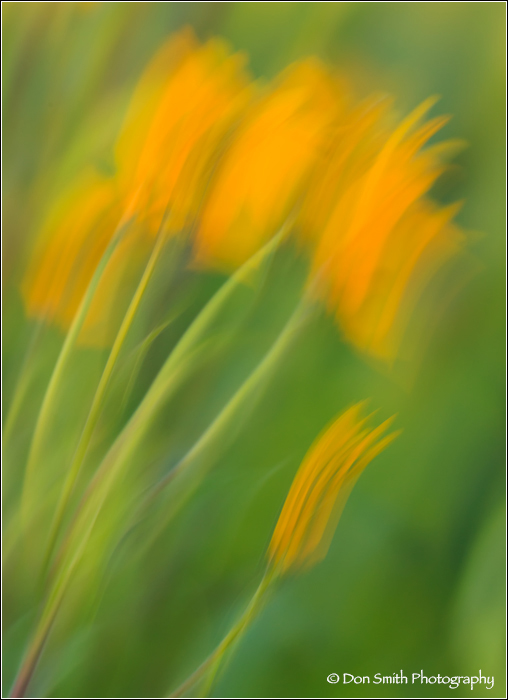
Dancing Sunflowers
Canon 5DMKIII, Canon EF 300mm f/4L IS USM Lens, f/5.6, 1/80th sec., ISO 400, Singh-Ray 77mm LB ColorCombo Polarizer Thin Mount Filter, Lexar Digital Media
Again, without the quality of the low-angled sunlight, this scene would have recorded too cold and uninteresting IMO, and earlier frames bore that out.
Please come back for Part 3, where I will explore the importance of studying art (color/depth) and design and show examples of how both can aide in improving your creative vision.
Free Video Sample :: Chapter 19 – Introduction to Luminosity Masks
2014 Photo Workshops – Complete List
2015 Photo Workshops
Software Discounts
Photomatix Pro 4.2 type in code at checkout: donsmithphotography 15% discount
Topaz Software type in code at checkout: SMITHPHOTO 10% discount
Helicon Focus click on link to receive 15% discount
Tony Kuyper Luminosity Action Palette click on link to receive a 15% discount
Hardware Discounts
MindShift Gear rotation180° Panorama rotating day hiker backpack
Special offer From Singh-Ray Filters: You will receive 15% off of any filter(s) you order when you call Singh-Ray direct and use my code – Smith 15: (800) 486-5501. Offer valid through June 13th!
Category: Landscape Photography Tagged: creative vision, don smith photo workshops, salsify, sunflwoers, Yosemite National Park
The Power Of Adding A Moon To Your Image
Posted on May 16, 2014
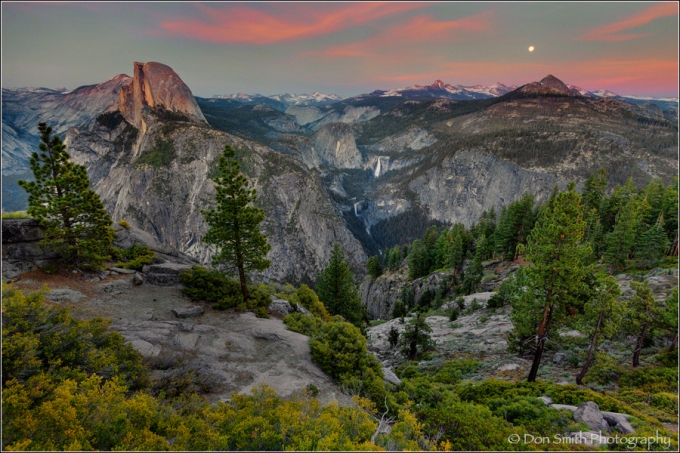
Moonrise Over Yosemite High Country, Ansel Adams Wilderness, Yosemite National Park
Canon 5DMKIII, 18mm, f/11, 2.5 seconds, ISO 100, Singh-Ray Thin LB Polarizer, Singh-Ray 2 stop, hard edge GND, Lexar Digital Media
If you have been following my posts for any length of time, then you know how important moon images are to me. They are so important in fact, that I plan many of my workshops around the full moon.
I captured this image Wednesday evening from Yosemite’s Glacier Point looking east over the Ansel Adams Wilderness just after sunset. I was co-teaching Gary Hart’s Spring Yosemite Workshop. We had the group at Glacier for a sunset shoot the evening prior.
Gary went around to all the participants and said he was going back to the Geological Exhibit Hut area to photograph the rising moon. About half the group chose to go while the other half stayed to shoot the setting sun. Gary asked if I would stay with that group.
The next day at image review, Gary showed his image and an audible sigh went up from those of us who missed the moonrise (we could not include it with Half Dome from our position). Within ten minutes, the group had voted to go back to Glacier that evening to try again.
One cool thing about the moon is that it rises, on average, about 50-60 minutes later each evening. The full moon always rises near sunset (usually, but not always, the day before the actual full moon). Gary calculated via topo software and a software program that on this particular evening, the moon would start rising to the left of Mt. Starr King about 30 minutes prior to sunset. His calculations were right on the mark. By the time I captured this image, it was 3 minutes past posted sunset. This allowed me to make the capture with only the aid of a Singh-Ray 2 stop GND so I did not lose detail in the moon; albeit very small in this image.
So why am I so moon crazy? I feel there is such an emotional draw to the moon – especially in wilderness settings. I photograph either full or crescent moons. Quarters and half moons tend not to hold as much appeal for me.
One cool thing about the moon is that it rises, on average, about 50-60 minutes later each evening. The full moon always rises near sunset (usually, but not always, the day before the actual full moon).
The other benefit of including a moon, even a small one such as this moon due to an extreme wide angle lens, is that they hold a tremendous amount of visual weight. Visual weight is not physical weight; rather, it acts as visual element that tends to keep the image in balance. Imagine this image sitting on a fulcrum point. Half Dome weighs the left side of the frame, Starr King (the peak below the moon) does act as a bit of a counter-balance for the scene, but the tiny moon completes the balance.
Including Half Dome in this frame with the moon dictated that I photograph it wide. I had this scene composed just as the moon started rising, but did not like my initial location because the foreground was bare on the left side.
I moved around until I found this scene with Half Dome framed by these two pines. I also liked that Nevada and Vernal Fall were now moved to the center of the composition. I climbed atop a boulder to include some of the foreground foliage as it was darker in tone and would hold the bottom of the frame better than just light-toned granite.
I used my 16-35mm Canon Series II lens at 18mm. Because I was so wide, I opted for an aperture of f/11 as I knew the lens would be near its sharpest in rendering the image. After that, it was just a matter of being patient and waiting for the dusk hues to arrive and add some color to the bands of cirrus clouds that were hanging around the Sierra crest.
NOTE: Due to the extreme wide angle, there is a bit of parallax distortion. I chose not to correct this as it dramatically cropped this image and changed the entire feel.
The most vibrant color arrived three minutes after sunset (something I was prepared for having witnessed this scene the evening before in similar conditions).
Everyone in the group seemed to have success. That means 13 more images similar to this one now exist, but only one other participant had the same foreground as me as he accepted my invitation to join me on the boulder.
Moon photography is not hard. There are many apps and software available to help you plan your own moon shoot. Perhaps the most popular is the Photographer’s Ephemeris and another is Photo Pills (for tablets and smart phones).
Free Video Sample :: Chapter 19 – Introduction to Luminosity Masks
2014 Photo Workshops – Complete List
2015 Photo Workshops
Software Discounts
Photomatix Pro 4.2 type in code at checkout: donsmithphotography 15% discount
Topaz Software type in code at checkout: SMITHPHOTO 10% discount
Category: Landscape Photography Tagged: Ansel Adams Wilderness, dusk, moonrise, Star King, Yosemite National Park
How Your Mood Affects Your Images
Posted on May 13, 2014
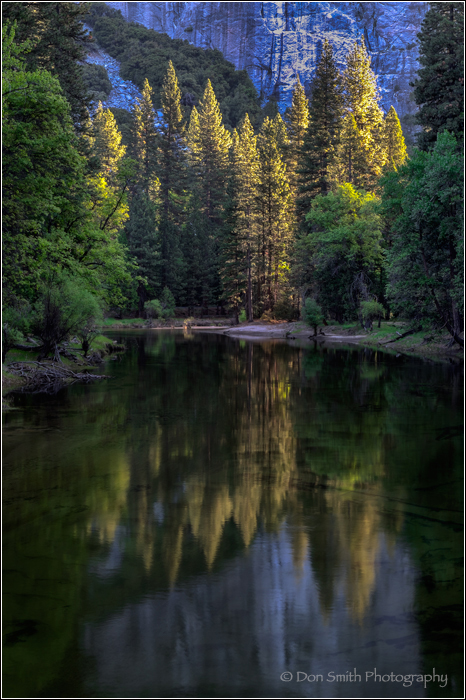
Reflection of First Light on Pines in Merced River, Yosemite National Park, California
Fuji XT-1 18-55mm (at 44mm), f/16, (3) exposures bracketed by 1 stop and blended as a 32-bit RAW file and adjusted in Lightroom 5, ISO 200, polarizer
Have you ever wondered how your mood affects your interpretation of a scene you are trying to capture?
Let’s take that a step further; how about a capture that you are trying to process?
It’s my opinion that mood plays a large role on how we interpret the natural world and how we choose to portray what we captured – assuming you are not after literal captures.
I find my most creative photography comes when I am in a good place mentally – happy and content. That means little to no stress or tension so I am free to give 100% of my attention to both creating and processing my scene.
This scene was a great example of how I was feeling a bit stressed because I had left my gear in the car and chose to work with a wide angle zoom lens.
I was co-teaching a workshop with Gary Hart in Yosemite and we had taken the group to El Capitan Bridge early yesterday morning. Wide angle was working great until I saw the sun backlight these pines.
Suddenly I realized, I needed longer glass. My car was parked about 80 yards away and I made a beeline, all the while stressing that I was going to miss the fabulous light that had nipped the tips of the pines.
I’ve been telling workshop students for 10 years to bring everything on a shoot. Here was a situation when I wished I would have listened to my own words!
By the time I got back, and got the correct lens on my camera (18-55mm), the light had already extended all the way to the base of the center pine. Was the moment ruined? Not really, though the mood was different.
I’ve been telling workshop students for 10 years to bring everything on a shoot. Here was a situation when I wished I would have listened to my own words!
Before I recomposed the scene, I needed a moment to recompose myself. I sensed my tension and took some deep, cleansing breaths to calm my mind and body. This allowed me to get back in the creative zone.
What I discovered by looking closely at my histogram was that I would need to bracket three exposures and blend in post. I centered my exposures around 1/4 second (1/2 plus 1/8) and made my three images.
As I settled back in to composing my image and my stress went away, I looked for tiny nuances in framing the scene. I decided that I wanted the lit pined centered vertically in the frame but not centered horizontally. Instead, I opted to give more room to the reflection of the pines and the river. Not so sure that I would have been as tuned-in had I still felt stress or if something in my home-life was troubling me.
As for processing, I started with luminosity masks (but felt rushed in my decision making). Later (this morning) determined that a 32-bit blend in Photoshop Merge to HDR Pro, without actually doing the HDR, then routing the file back to Lightroom would be the best method for processing this image.
32-bit processing allowed me 20 stops of adjustable tones instead of the standard 10 stops in 16-bit files. This in turn allowed me to fine-tune the subtle tones in the file far more easily than working with a single exposure and without the risk of pulling up noise in the darker regions of the image.
BTW – I teach this in my new video series listed below. Click on the link and the files will download right to your computer!
I’m on a break from teaching Gary’s workshop and it took about 20 minutes to get this image the way I wished in Lightroom. This morning I am very calm and peaceful and I think those emotions transcended into how I processed this image.
I believe the image conveys my emotions. So pay attention to your mood. It will come across in your images. I happen to think that is a good trait to have as that allows your personality to be a part of your image-making!
Free Video Sample :: Chapter 19 – Introduction to Luminosity Masks
2014 Photo Workshops – Complete List
2015 Photo Workshops
Software Discounts
Photomatix Pro 4.2 type in code at checkout: donsmithphotography 15% discount
Topaz Software type in code at checkout: SMITHPHOTO 10% discount
Category: Landscape Photography Tagged: El Cap, Merced River, sunrise, Yosemite National Park
Nasty Weather Makes For Great Image Opportunities!
Posted on April 28, 2014

Raindrop On Dogwood Flower, Yosemite National Park, California
Canon 5DMKIII, 100mm macro, f/10, 1/15th, 800 ISO
“Oh, the weather outside is frightful…”
So what do you do when the weather turns bad? Curl up with a good book in front of a fire? That sounded like a really good idea this past Friday when a late-winter storm descended upon Yosemite Valley.
But I actually planned this day. Yeah, I know, sounds crazy, but bad weather often makes for awesome images!
The dogwoods are blooming early in the Valley and it had been three years since I’d had a chance to photograph them. I had two days on my schedule (Wednesday or Friday) that were open for a day trip (I have less than a three hour drive to the Valley from my home).
Wednesday’s forecast was for sun – tough conditions to shoot these delicate blooms. But Friday’s forecast looked promising – originally it called for snow! This is pretty unheard of for California this late in the year. I immediately switched plans and awaited what I hoped would be a winter wonderland.
But as is often the case, Mother Nature had other plans. The snow did indeed arrive, only the snow level was about 600-1,000 feet higher than the Valley floor (4,000 – 4,200 feet). Instead of the white stuff, we (Gary Hart and Mike Hall joined in the fun) were greeted with the wet stuff.
Fortunately there was no wind. At times there was a bit of a breeze, but nothing too hard to deal with. It did rain steadily and even intensified late in the afternoon.
We broke our shooting sessions into two 2 1/2 hour stints, shooting nothing but blooming dogwood. Gary had been in the Valley shooting the previous Tuesday, so he knew the areas that held the most promise.
Today’s image comes from our afternoon session near the turnout across from Bridalveil Fall. I walked around looking for a bloom that would be slightly higher than eye-level. This particular flower caught my eye immediately because of the rain drops that were dripping off the slanted flower.
I envisioned turning the muted highlights to out-of-focus donuts, and just played with a combination of shutter speeds and apertures until it worked. I was fortunate that my camera was on the exact plane on a line between the rain drop and the bud of the flower to hold focus on each.
Moreover, I was also fortunate that the second flower, even though it was out-of-focus, was a bit more yellow as to not to compete for attention with the foreground flower.
The real key is the rain drop. That is what drew my attention and that is what makes this image work. If it was not for a willingness on may part to work in the rain, then this image would have never existed.
Nasty weather usually bodes well for exciting (or at least different) imagery, Yet, one has to be willing to put up with the discomfort of working in such conditions.
Snow is actually easier than rain, but rain is doable as long as it is not accompanied by a lot of wind – especially when trying to shoot closeups with macro lenses!
Here are a few tips for shooting in the rain that will help to alleviate your frustrations:
Dress appropriately: Gore-Tex or water proof clothing.
Use an umbrella: I took along a Nike golf umbrella that really helped keep the rain off my camera and lens.
Cover the camera: I don’t get fancy here. Plastic garbage bags work just as well and $100 covers – with less hassle. I do use either micro fiber cloths or more preferably large car shammy’s to wipe down equipment and lenses.
Keep an eye on your lens filter: the shammy’s work great here. It is imperative that you keep rain drops off you lens – check every frame if necessary.
Take breaks: it is necessary to take a break every now and then to dry off equipment (and yourself). A sort of recharge for both machine and human! Staying warm and dry will go a long way towards improving one’s creativity. Hard to be creative when you are miserable.
Water proof boots: self-explanatory 🙂
Shutter speeds: slower shutter speeds will allow the rain to blur and not record as streaks (unless you want this). Macros allow for extremely limited depth-of-field which also helps eliminate streaking rain.
So the next time the weather turns bad, when all the tourists are running inside, grab your camera and head outside. Not only will your images be more interesting, but more-than-likely, you’ll only be shooting with other pros!
Free Video Sample :: Chapter 19 – Introduction to Luminosity Masks
2014 Photo Workshops – Complete List
2015 Photo Workshops
Software Discounts
Photomatix Pro 4.2 type in code at checkout: donsmithphotography 15% discount
Topaz Software type in code at checkout: SMITHPHOTO 10% discount
Helicon Focus click on link to receive 15% discount
Hardware Discounts
MindShift Gear rotation180° Panorama rotating day hiker backpack
Category: Landscape Photography Tagged: California, dogwood, rain, rain drops, spring, Yosemite National Park
Does Your Photography Touch Your Soul?
Posted on April 14, 2014
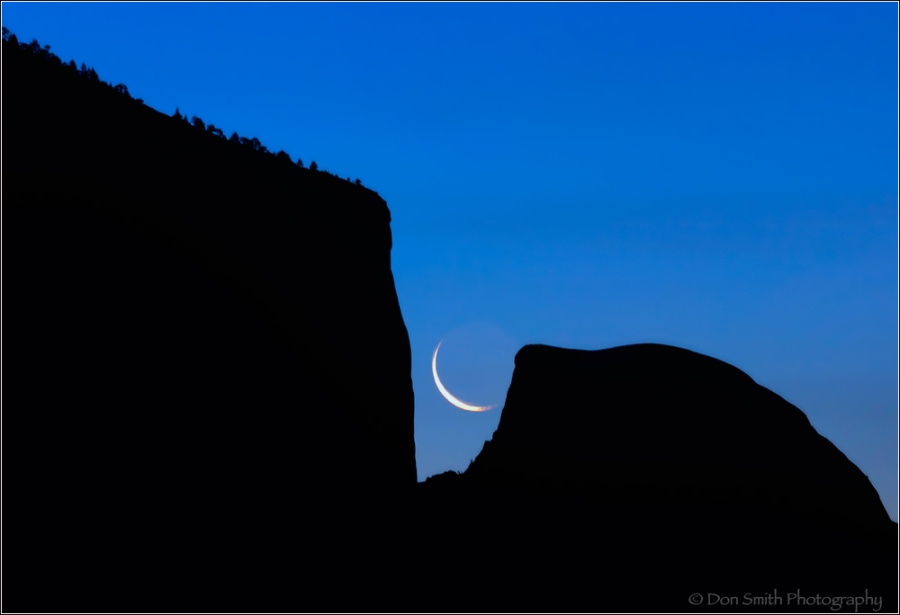
Crescent Moonrise Between El Capitan and Half Dome, Yosemite National Park, California
Canon 1DsMKIII, 300mmL @f/11, 4 seconds, 200 ISO
My wife Beri made an interesting comment the other day that really got me thinking. She said, “you’ve been doing your photography professionally for over 35 years and you still have the passion – that’s why you like making pictures every day.”
I never quite thought about it that way but she is right – I still do have the passion for crafting images. To refine that statement a bit more, I believe it is the creation process that really has me glued to my cameras.
I’ve thought back over the years of the number of interesting places and people I’ve had the opportunity to see and meet – all because of my love affair with my camera. Pretty cool!
In the people realm, I’ve had the opportunity to photograph presidents to rock stars. In the landscape realm, I photograph regularly what is on most photographers “bucket lists.”
This image was captured back in spring 2011 while teaching a workshop with Gary Hart in Yosemite. Gary had calculated that this crescent moon would rise at dawn between the opening of El Capitan (left) and Half Dome (right), perhaps the two most recognizable monolith formations in all of Yosemite.
In the people realm, I’ve had the opportunity to photograph presidents to rock stars. In the landscape realm, I photograph regularly what is on most photographers “bucket lists.”
We had our group in position in the dark and cold and anticipated this moment. Gary’s initial calculated time came and went and I could see he was quite concerned. Then, within minutes, we could see the tip of the bottom right of the crescent as it began to emerge from behind El Capitan on a path to our right and upwards.
I began making images immediately and rechecked my exposures to make sure I was keeping the monoliths in silhouette. Never once did HDR cross my mind. I believed that the moment belonged to the crescent sandwiched between these two incredible granite formations – a simple play of black and white laid against a cool blue background.
I tired reminding myself to enjoy this moment. I was witnessing (with 13 others) a unique and beautiful moment in nature. I no longer felt cold. I no longer felt sleepy. I no longer craved my morning coffee. What I was witnessing through my viewfinder was all that mattered to me at the time. My soul was alive. I was alive!
So yes, you could easily say photography touches my soul. That creative moment when it all comes together and the image is safely captured by my senses and sensor.
Yet it is my connection with that scene and my determination of how I want my viewers to witness and feel what I witnessed and felt that is also what moves me. That is what we visual artists do: we share visual moments that hopefully stir the senses of our viewers.
This moment touched my soul and I hope it touches yours!
Free Video Sample :: Chapter 19 – Introduction to Luminosity Masks
2014 Photo Workshops – Complete List
2015 Photo Workshops
Software Discounts
Photomatix Pro 4.2 type in code at checkout: donsmithphotography 15% discount
Topaz Software type in code at checkout: SMITHPHOTO 10% discount
Helicon Focus click on link to receive 15% discount
Hardware Discounts
MindShift Gear rotation180° Panorama rotating day hiker backpack
Category: Landscape Photography Tagged: California, cresecent moon, dawn, moonrise, silhouette, Yosemite National Park
Working a Scene
Posted on February 24, 2014
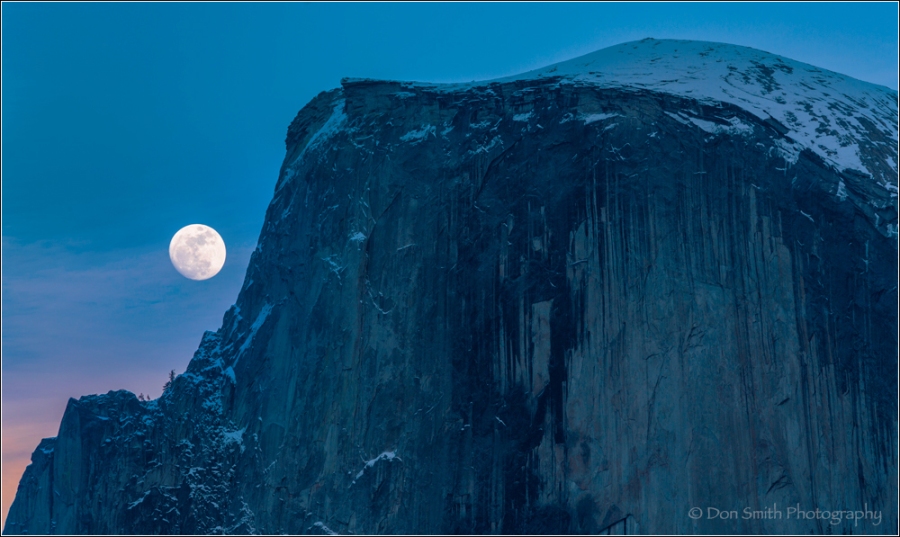
Winter Moon and Half Dome, Yosemite National Park, California
Canon 5DMKIII, 280mm, f/11, 0.3 sec., ISO 100
Back in the film days, I shot exclusively with transparency film (chromes). The margin-of-error was very slight. Vary a half-stop on exposure and it could mean the difference of a highlight blown or captured.
Fast forward into the digital era and exposures are still critical, but much easier to calculate thanks to histograms (what I call an exposure coach). Moreover, enabling Highlight Alert keeps an eye on blown highlights that you may not be able to discern with your camera’s tiny histogram display.
Once the exposure is calculated, you are really free to just work the scene, in other words, bracketing your composition.
A couple weeks back, I was co-instructing Gary Hart’s Yosemite Winter Workshop. Gary had calculated a moonrise alongside Half Dome at sunset from Camp 6.
I was stranded without my 24-70mm, having left it in another bag instead of my backpack. That forced me to see the scene with my telephoto lenses – not a bad thing, but limiting.
As the moon appeared, I started with a telephoto and captured the scene you see above. When photographing a moon with the surrounding landscape, we are limited to a small window when the moon (lit by the sun), blends with the surrounding landscape (lit by indirect light). This window can be less than 10 minutes.
I loved the stark lines created by a row of cottonwoods at the base of my next image. Because I could not include enough of the Merced River to make sense to the viewer, I framed the scene to eliminate it.
This image is a blend of (4) exposures utilizing luminosity masks. The masks allow for a seamless transition by isolating tonality. I offer (5) videos on luminosity masking in my new instructional video series, A Simplified Method to Workflow.
I love this technique so much that I have ditched all of my HDR programs!
My next image was a medium telephoto to give the viewer more of a sense of size of Half Dome.

Canon 5DMKIII, 98mm, f/11, 0.3 sec., ISO 100
Just a note here about visual weight. A moon adds tremendous visual weight to a composition. Without the moon, this image would be heavily weighted to the right because of the dark pines. This small moon adds equilibrium to the scene and keeps it in balance. Crescent moons can do the same!
By the time I captured this last frame, the window was about closed! As you can see, the exposure remains the same as the light on the moon is constant. The show was over, but a fun one to shoot.
So next time out, work your scene. The key is not to rush. Make sure the composition you are working on is the best you can make it. Concentration is key. Keep an eye on your histogram and and eye on your edges. Think about “visual weight” and above all, have fun!
Free Video Sample :: Chapter 19 – Introduction to Luminosity Masks
2014 Photo Workshops – Complete List
2015 Photo Workshops
Software Discounts
Photomatix Pro 4.2 type in code at checkout: donsmithphotography 15% discount
Topaz Software type in code at checkout: SMITHPHOTO 10% discount
Helicon Focus click on link to receive 15% discount
Hardware Discounts
Special Year End “Black Friday” Offer From Think Tank Photo NOTE: (Use Promo Code WS-643)
MindShift Gear rotation180° Panorama rotating day hiker backpack
Category: Landscape Photography Tagged: California, Camp 6, Half Dome, Merced River, moonrise, sunset, twilight, Yosemite National Park
Finding Winter Images in the Middle of a Historic Drought!
Posted on February 17, 2014

Blowing Mist Bow, Yosemite Falls, Yosemite National Park
Canon 5DMKIII, 280mm, 1/50th, f/11, ISO 100, Singh-Ray LB Warming Polarizer
I spent last week co-teaching Gary Hart’s Yosemite Winter Workshop. Unless you have been out of the country or in a coma, then you are aware that California is suffering through its worst drought in 100 years!
While not attempting to trivialize the seriousness of this situation, it goes without saying that looking for winter images to photograph have been few and far between.
Fortunately, some much needed rain and snow fell in the Sierra Mountain Range just prior to the start of the workshop, but the snow level was too high to allow for any fresh snow to fall on the Valley floor (4,000 feet); instead, sticking to the monoliths and mountains that surround the Valley.
This much needed moisture did allow many of Yosemite’s falls to flow. It also allowed for Horsetail Fall to flow, allowing for some beautiful light to highlight the fall.
The image above was captured as the sun crested the Valley’s eastern escarpments. The sun’s low angle created a mist bow at the base of Upper Yosemite Fall. Wind and updrafts from the crashing water served to blow the water and the bow and create a kaleidoscope of color.
Earlier that morning, we had taken the group to a location locals call Tahiti Beach. While walking the group to our shooting position along the bank of the Merced River, I noticed a portion of the Valley floor covered in browned Aspen leaves.
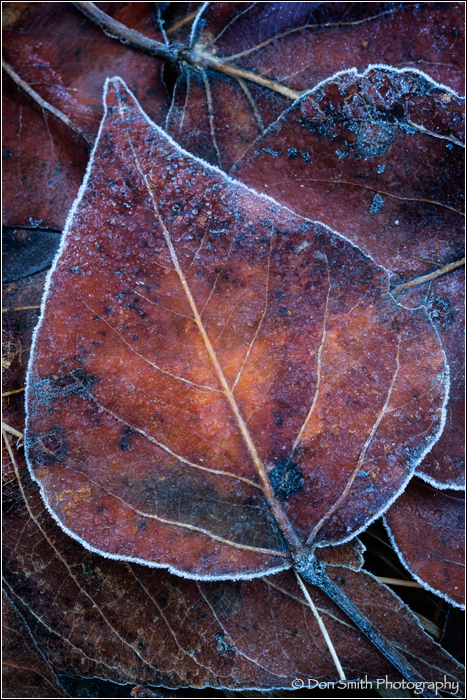
Frosted Aspen Leaves, Tahiti Beach, Yosemite National Park
Canon 5DMKIII, 100mm macro, f/16, 8 seconds, 100 ISO, circular polarizer
I scouted around until I found a leaf prominently positioned amongst a bed of other leaves. What caught my eye more than any other feature was that I noticed that this particular leaf (pictured above) was rimmed with a small border of frost. The upper portion of the leaf was also dotted with frozen dew.
One usually does not think “macro” when photographing in Yosemite, but the Valley offers some really awesome opportunities; it’s just a matter of diverting one’s attention from the “grand view” scenes that abound.
Another “out of the box” image opportunity that caught my eye occurred at an area called Camp 6 along the bank of the Merced River. The group was awaiting a moonrise that Gary had plotted near Half Dome at sunset (I’ll post that image in a separate blog).
While waiting, I tried making an image of a row of dormant cottonwoods reflecting in the river. Frozen captures were not translating my connection to the scene; thus, I decided to vertically pan my camera to add a bit of movement to the scene.
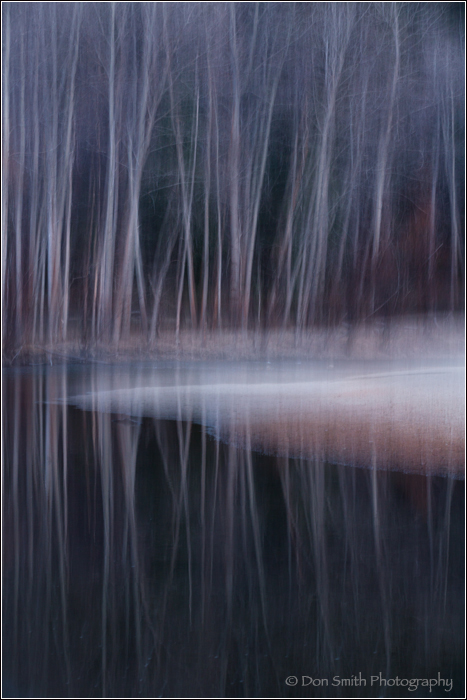
Cottonwoods and Merced River, Camp 6, Yosemite National Park
Canon 5DMKIII, 130mm, f/11, 1/4th sec., 200 ISO, Singh-Ray LB Color Combo Polarizer
My camera was mounted onto my Really Right Stuff TVC-34L tripod with a BH-55LR ballhead. During my brief 1/4th second exposure, I moved the camera in a downwards motion. I attempted about 10 frames, but chose this one because the line of the bank remained relatively unblurred.
Not quite sure why this happened as the other frames all produced a second line for the bank. Oh well, I got a bit lucky! Anyway, this is not a new technique, but it certainly worked for this image.
Processing this image involved a bit of luminosity mask wizardry (I love using these masks). I first created a Curves adjustment layer. Next, I used the Targeted Adjustment Tool to both brighten the tree trunks and darken the river. I then created a luminosity mask that selected the 50% brightest pixels but created it based on this Curves layer adjustment.
Masks created in Photoshop’s Channels will pick-up the tonality of the current state of the image. Now that the mask was created, I trashed the Curves layer (I only used it to create the mask). I then applied a new Curves adjustment layer and found I had finer control in separating the trees from the water. Sounds more confusing than it really is. BTW – if you want to improve upon your processing skills, check out my video series listed below.
We still have another 6-8 weeks where we could get some substantial moisture her in California. I’ll keep out fingers crossed and camera ready!
Free Video Sample :: Chapter 19 – Introduction to Luminosity Masks
2014 Photo Workshops – Complete List
2015 Photo Workshops
Software Discounts
Photomatix Pro 4.2 type in code at checkout: donsmithphotography 15% discount
Topaz Software type in code at checkout: SMITHPHOTO 10% discount
Helicon Focus click on link to receive 15% discount
Hardware Discounts
Special Year End “Black Friday” Offer From Think Tank Photo NOTE: (Use Promo Code WS-643)
Category: Landscape Photography Tagged: aspen leaf, California, cottonwood trees, macro, Merced River, mist bow, winter, Yosemite Falls, Yosemite National Park
Two Evenings at Horsetail Fall
Posted on February 13, 2014

Horsetail Fall and Lit Clouds, Yosemite National Park
Canon 5DMKIII, 145mm, f/16, 1/5th sec., 100 ISO, Singh-Ray LB Warming Polarizer
This past Monday and Tuesday evening, while co-teaching Gary Hart’s Winter Yosemite Workshop, we took our group to a location along Southside Drive in Yosemite Valley in an attempt to get the magical light on Horsetail Fall that occurs for a small window of time each February.
Surprisingly, there were not many photographers, something I’m sure that will change this weekend as it is a three-day holiday for most.
Thanks to a series of storms that finally deposited some moisture over a parched California, there fortunately was enough snow/rain to once again get this seasonal fall flowing again.
Last week, (from what I was told) the fall was bone dry. What was special about Monday evening were the clouds, especially the ones hovering at the summit of El Capitan.
As the warm light started to arrive, the bright clouds picked up some of the warmish color. Set against the darker clouds behind them, it made for an exciting composition.
Unfortunately, for those who traveled a long distance to get the classic warm orange and red light that has been captured in numerous images over the years, it did not arrive on Monday as the cloud cover to the west was too thick. It sure would have been awesome have had a hole open-up near sunset, but it was not to be.
No one was too disappointed, quite the contrary; this scene was was rather unique and beautiful in its own right
The next day we observed clear skies from our hotel at El Portal. We thought we would have a good shot at possibly getting the warm light, so we headed back to our Horsetail location along the bank of the Merced River.
This particular evening there were more photographers, but still not the hoards that we have seen in past years.
About 15 minutes prior to sunset, the warm light started to mute and eventually disappear. We were determined to wait it our and, as you can see below, it ended up being a good call.

Warm Light, Horsetail Fall, Yosemite National Park
Canon 5DMKIII, 245mm, f/16, 0.6 sec., 100 ISO, Singh-Ray LB Warming Polarizer
I captured this image three minutes prior to posted sunset. On a level of 1 to 10, with 10 being the blood red lava light, I would rank this image at a 9.
We were literally within a couple minutes before this light would have narrowed directly on the fall (with perhaps a bit spilling to the left as you see it) with a thin red band of light hitting the fall dead-on. Unfortunately, a minute after I captured this frame, the light flickered out for the evening.
Last night (Wednesday) we took the group to Camp 6 to shoot a moonrise with Half Dome. We were satisfied with our two attempts at Horsetail. We did get the moonrise (I will post with my next blog) and found out from friends that no warm light hit Horsetail.
If you plan to come up this weekend, be prepared for the hoards of photographers all after the same shot. Park is designated areas only (the rangers are setting cones to block portions of both Northside and Southside Drives for “event parking.” If you just pull off the road, you will be ticketed – keep wheels on pavement!
Free Video Sample :: Chapter 19 – Introduction to Luminosity Masks
2014 Photo Workshops – Complete List
2015 Photo Workshops
Software Discounts
Photomatix Pro 4.2 type in code at checkout: donsmithphotography 15% discount
Topaz Software type in code at checkout: SMITHPHOTO 10% discount
Helicon Focus click on link to receive 15% discount
Hardware Discounts
Special Year End “Black Friday” Offer From Think Tank Photo NOTE: (Use Promo Code WS-643)
Category: Landscape Photography Tagged: February, Horsetail Falls, lit clouds, warm light, waterfall, winter, Yosemite National Park
Memorable Moment :: Horsetail Fall, Yosemite National Park
Posted on January 25, 2014

Horsetail Fall, Yosemite National Park, February 18, 2009
Canon 1DsMKIII, 180mm, f/11, 1.5 sec., ISO 100
Let’s face it, nature’s phenomenon’s are cool to photograph!
Each February brings the potential for a chance at photographing Yosemite’s famed Horsetail Fall, a small seasonal fall fed by snowmelt from high atop Yosemite’s El Capitan.
The fall itself can be something of a challenge to locate. I discovered this fact back in 1998, the first year I ever attempted finding and photographing the tiny fall made famous by the Galen Rowell image that appeared in his book, Mountain Light.
Unlike its larger brethren (Yosemite Falls, Bridalveil Fall, Vernal Fall, and Nevada Fall, this tiny fall clings tightly to the side of the giant monolith and is not immediately noticeable.
When conditions are perfect, what looks like red lava spilling down the side of the monolith is actually directed rays of light from the setting sun that align perfectly with the tiny fall.
NOTE FOR THOSE WHO HAVE NEVER WITNESSED THIS PHENOMENON IN PERSON: Other than setting the white and black point and adding a touch of contrast via an S-Curve to the midtones in Lightroom, this is exactly the color the fall looked. I have actually gone back to the RAW file and tried, unsuccessfully, to saturate the red. It was already at maximum saturation thanks to Mother Nature!
Early last February, I wrote a blog where I said, “On February 18, 2008, I witnessed and photographed Horsetail at its blood-red state. I was atop a snow mound along Southside Drive with two of Gary’s (Gary Hart) workshop participants and another good friend of mine who happened to make a day trip from the Bay Area. We were surrounded by well over 100 photographers. Approximately 25 minutes before sunset, the sun’s rays were obscured by clouds and the light abruptly fell off of Horsetail. I told our group that we were staying until 15 minutes past posted sunset. As sunset came and went, most of the assembled group packed and left. Then, exactly three minutes after sunset, a warm pink glow appeared in the middle of the fall and within a minute, had spread from top to bottom and lasted for another 3 1/2 minutes. It was the blood red light that looked as if someone had opened a valve on molten lava – it was beyond amazing!”
“So what conditions are required for this light? That’s the million-dollar question and one that I have yet to hear a definitive answer.”
I had never before, nor since, seen this fall lit top-to-bottom with this light – that is how elusive it is.
So what conditions are required for this light? That’s the million-dollar question and one that I have yet to hear a definitive answer. I have been contacted quite a bit for my own opinions since capturing this image. Last year a production company from the BBC contacted me to be a part of a documentary they were filming (that appeared on our country’s The Weather Channel) about Nature’s Phenomenons. Unfortunately, schedule conflicts prevented me from being able to conduct the interview (I was in Maui and the studio portion of the documentary was being filmed in Colorado), but this image was used.
What I can tell you is this. On the evening I made this image, and on another evening where I saw somewhat similar conditions, there were broken clouds hovering over Yosemite Valley. There also needs to be adequate snow atop El Capitan, temperatures warm enough to melt the snow, and a window starting February 16th-23rd for top-to-bottom light.
I’ve heard various theories that the setting sun’s final warm rays bend up-and-over the horizon and align precisely with the fall (that fact I will concur and have witnessed on clear-sky evenings). I’ve further read or heard that the intensity or saturation of the red is the scattered light being re-directed from the clouds. I’ve also read that Tule fog (a thick ground fog) in the central Valley helps. Is all this true? I have no idea – sorry!
I do know this. The chance at capturing this scene has lured photographers from around the world. On any given late-afternoon, photographers numbering in the 100’s can converge on two primary viewing locations (the picnic area located off Northside Drive where Rowell made his image, and from the banks of the Merced River off Southside Drive – approximately 9/10ths of a mile from the Cathedral Beach picnic area – where this image was captured).
I’ve been asked numerous times if I shot this from an elevated perch and the answer is no. I was actually on a snowbank in the middle of the Merced River. I agree that it does look as if I am shooting down at the fall, but I believe it is an illusion due to the slope atop El Cap.
The dates for this year’s window is rapidly approaching, but we desperately need some snow. California has been enjoying springlike conditions for the past 5 weeks. It’s time for winter to arrive!
2014 Photo Workshops – Complete List
5th Annual Kauai Workshop – Garden Isle and Tropical Paradise – June 20-24, 2014 (3 spots remaining)
2015 Photo Workshops
Software Discounts
Photomatix Pro 4.2 type in code at checkout: donsmithphotography 15% discount
Topaz Software type in code at checkout: SMITHPHOTO 10% discount
Helicon Focus click on link to receive 15% discount
Hardware Discounts
Special Year End “Black Friday” Offer From Think Tank Photo NOTE: (Use Promo Code WS-643)
Category: Landscape Photography Tagged: don smith photo workshops, February, Horestail Fall, red light, Yosemite National Park
‘Stupid Is As Stupid Does’ – Never Hike Alone!
Posted on January 12, 2014
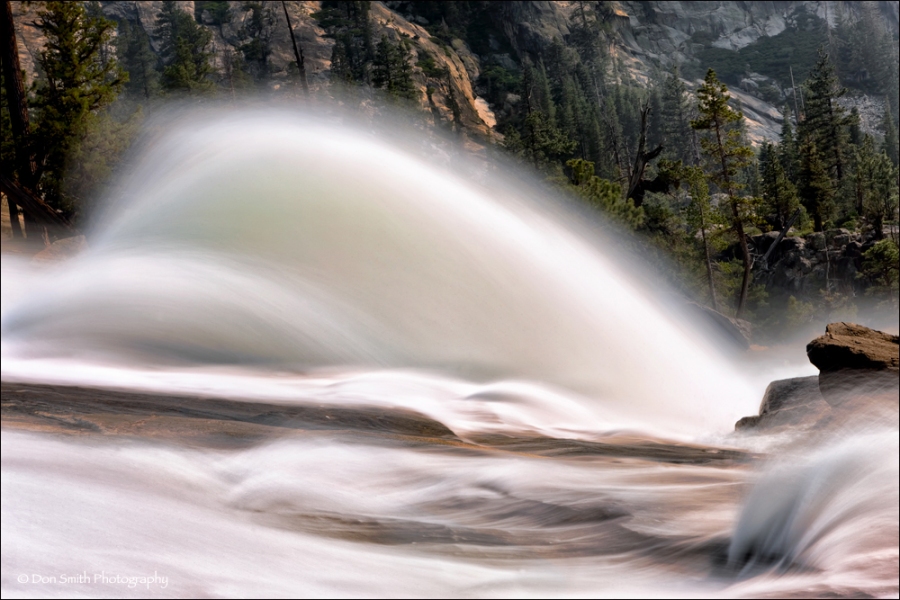
Waterwheel Falls, Tuolumne River, Yosemite National Park
Canon 1DMKIII, 70mm, f/22, 1 second, ISO 50, polarizer
I have done some stupid things in my life but perhaps nothing more life-threatening than the time I decided to hike alone in the Yosemite back-country to capture this image of Waterwheel Falls back in August of 2009. As Forrest Gump once quipped: “stupid is as stupid does!” And believe me – I was STUPID!
Having hiked quite a distance the day before, I decided to make the 18.5 mile round-trip trek to Waterwheel Falls in Yosemite’s high country the next day.
This had been on the “to do” list for quite some time. I was in Yosemite on a short family holiday and had hiked the 13.8 mile Pohono Rim Trail along the south side of Yosemite Valley the day before. Perhaps feeling a bit more spry than my age should allow, I decided to set out alone (my wife and kids were smarter than me) for an afternoon/evening trip starting from the top of Tioga Pass at 8500 feet.
I was well-stocked with power bars, trail mix, bottled water, head lamps, map, and a water purifier. I knew the Tuolumne River would follow the path so I would never be without an adequate supply of drinking water. It took 4 hours of steady hiking (stopping only twice along the scenic trail) to reach my destination. I allowed myself one hour shooting time (not nearly enough in retrospect) and had my planned departure at 5:30pm (realizing it would take a minimum 5 hours to get back to my car as I would have 2600 feet of elevation gain).
“I actually slipped once and took a 30-foot slide on my rear end (now I know why the call it ‘polished’)!”
The Falls were awesome but I have seen even more impressive images on huge snow years. I wanted to convey the power and grace that the waterwheels (some as high as 30-feet as the cascading river hits deep ruts in the granite surface) and decided to use a Singh-Ray variable neutral density filter where I could dial in -2 to -8 stops of light and allow for motion with the water.
The cool thing about these falls is that there are no railings (this ain’t Disneyland folks)! I had to be careful on the granite because it had some black algae growing in spots and also, it was slick from polished glacial. I actually slipped once and took a 30-foot slide on my rear end (now I know why they call it “polished”)! I got as close to the water as I could (basically right to the edge for this image) and just tried to play with various compositions and shutter/aperture settings.
Unfortunately the trip back was fought with problems. Parts of the trail were under water and my wet socks soon led to painful blisters. I also came face-to-face with a somewhat aggressive bear (throwing a huge rock finally scared it away after it had backed me up against the river and was within 15 feet of me), fell into a creek when a log I was crossing unexpectedly turned (fortunately my Tamrac backpack which was completely submerged protected my camera and lenses, but there’s more to that story), and got lost for the final three miles as I made a wrong turn off my trail (it did not show on the map).
“As I got midway across, one of the logs rolled, and my leg got wedged in-between and I went backwards into a large pool of water. I actually remember thinking, ‘I could die here and no one will find me until the morning.’ ”
It was the “fell into the creek” part that almost cost me my life. It happened around 11pm. I had remembered crossing what I thought was a small feeder creek by carefully maneuvering across three small aspen trees that were laid horizontally across the creek as a makeshift bridge.
As I got midway across, one of the logs rolled, and my leg got wedged in-between and I went backwards into a large pool of water. As I reached to pull myself up, the log rolled again and I became completely submerged. I could barely keep my face above the water’s surface. Now I was downright scared! I actually remember thinking, “I could die here and no one will find me until the morning.”
I knew I had one more chance. If the log I was reaching for rolled once more, I would have been trapped completely under the water and would have drowned. This time, mustering all the strength I had left, I reached for the outermost log and it wedged tight against my trapped leg and I was able to pull myself up and out of danger.
I really had no time to feel sorry for myself as I was quickly losing the moon (which was helping me navigate out of the forest). I did indeed get lost once more upon reaching Tuolumne Meadows (I could not find my way across the river), but I eventually found Tioga Pass Highway.
“The total time of the hike was almost 11 hours and I finally made it back to my car at midnight thoroughly exhausted and lucky to be alive!”
I flagged down three cars. The first was full of teenagers who had no room, the second was a tow truck on the way to an accident, and the third “thank God” was a ranger (on the way to the same accident). I told the him I had been hiking for almost 11 hours and was dehydrated. He said I could either wait where I was (he would radio for help) or I could walk the last half-mile to my car. I opted for the latter!
The total time of the hike was almost 11 hours and I finally made it back to my car at midnight thoroughly exhausted and lucky to be alive!
I made the 2-hour drive down to my hotel and limped into my hotel room to my sleeping wife and kids at 2am. She woke up and I told her what happened and was expecting a “I told you so!” Instead, I got a big hug.
A lesson was learned the hard way: NEVER HIKE ALONE – ESPECIALLY AT NIGHT IN THE WILDERNESS!
NOTE: My family and I returned to where I had fallen into the pool of water the following summer. My wife and I needed to see it in the daytime. Oftentimes situations in our minds grow bigger (you should have seen the one that got away) than reality. When we saw the pool and the logs we just looked at each other and said a silent prayer. Suffice it to say, in this case, the opposite was true; if I had nine lives, I had no doubt used eight of them!
2014 Photo Workshops – Complete List
5th Annual Kauai Workshop – Garden Isle and Tropical Paradise – June 20-24, 2014 (3 spots remaining)
Software Discounts
Photomatix Pro 4.2 type in code at checkout: donsmithphotography 15% discount
Topaz Software type in code at checkout: SMITHPHOTO 10% discount
Helicon Focus click on link to receive 15% discount
Hardware Discounts
Special Year End “Black Friday” Offer From Think Tank Photo NOTE: (Use Promo Code WS-643)
Category: Landscape Photography Tagged: don smith photography, waterwheel falls, Yosemite National Park
Recent Posts
- Why I Will Never Fly American Airlines Again :: At Least Not After Next Tuesday…
- New Blog Site For Don Smith Photography!
- Do You Look Or Do You See? Developing Your Creative Vision :: Part 2 of 3
- Do You Look Or Do You See? Start With 10,000 Hours Of Practice :: Part 1 of 3
- Photographing Wildflowers In The Wind At Big Sur’s Garrapata State Park

